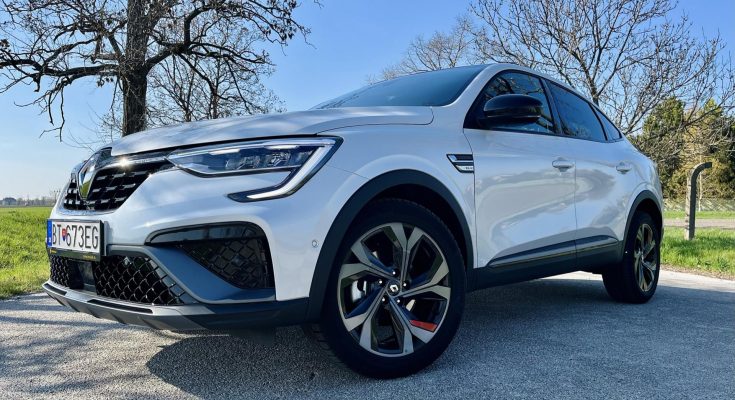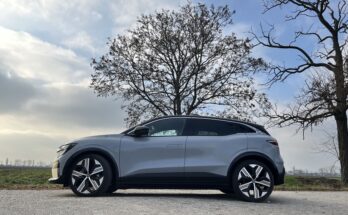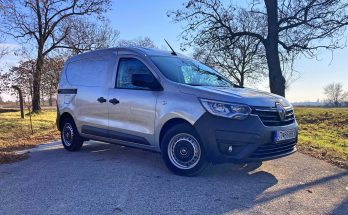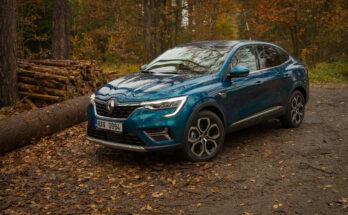The French manufacturer Renault has ventured into waters in which it has never operated before. Some time ago, he started selling the Arkana model, which is a stylish crossover, combining the body of a classic SUV with the shapes of a coupe. And we tried it ( again ) in the hybrid version E-Tech Hybrid 145.
When you look at the Arkana, you immediately recognize that it belongs to the Renault family. It has the typical headlights with the current signature of daytime running lights, the rear lights are the same and therefore run the entire width of the rear part, up to the car company emblem in the middle of the trunk lid.

However, the shapes of the body when viewed from the side are less well known. From the front to the B-pillar, it is quite a regular small SUV ( Captur ), but from the B-pillar to the back, the silhouette already drops to be finished off by a decent spoiler on the trunk lid. The fact that the car can impress was also confirmed by random passers-by, who occasionally exchanged a few sentences on the topic of design and price.

However, nothing revolutionary is happening inside and the interior is well known from other models of the brand. In the tested model, equipped with the RS Line, it combines a large vertically positioned touch screen with physical buttons, used, for example, to heat the seats, activate the electric mode, turn signals or, for example, the automatic parking assistant. The heating and air conditioning control panel can also be found below them.

You don't have to be afraid of any impracticality. Thanks to the shape of the rear part, the luggage compartment is smaller than, for example, in the Capture, but the crew in the front or the back does not have to be particularly limited.

Renault Arkana, as completely original as it looks, uses the same CMF-B chassis platform as, for example, the aforementioned Captur, from which it is based. Unlike it, however, it does not have a plug-in hybrid drive, but only a pure hybrid, like the Clio , for example.

The Arkana's hybrid drive combines an electric motor with an output of 36 kW/49 hp and a torque of 205 Nm, with a starter-generator that helps with another 15 kW/20 hp and 50 Nm. Electricity production is handled by a good old atmospheric four-cylinder 1600 with indirect fuel injection, originally from the workshop of the alliance Nissan. Its performance is not dazzling, and in the language of numbers it means 69 kW/94 hp and 148 Nm of torque. The total system output is 105 kW/143 hp. Not much for a hybrid, you say…
However, the dynamics are sufficient. Technical data reveal that the hybrid Arkana E-Tech can accelerate from 0 to 100 km/h in 10.8 seconds and the maximum speed is 172 km/h. If you look at the other versions on offer, you will find that they are faster on paper. But the hybrid is not about speed, it is more about saving fuel. And in this respect, the hybrid Arkana is not bad at all.

It is possible to drive between 4 and 5 l/100 km, as long as you anticipate, do not unnecessarily add too much and try to work as much as possible with electricity and reaching junctions or turns.
This car is a hybrid, or a full-hybrid, which means that it does not have a very large battery (1.2 kWh) and can travel only a few kilometers purely on electricity. However, this is the type of hybrid where you don't have to worry about anything at all. The drive unit handles the electricity as needed and whenever possible and appropriate, it deactivates the internal combustion engine and tries to go purely on battery electricity.

The battery charges completely by itself and this is a big advantage over plug-in hybrids, where the battery is large and has to be charged from an external source (i.e. with a cable from an outlet or charging station). Here, the battery is recharged while driving – by recuperation during engine braking or with the help of the internal combustion engine. An indicator in the digital dashboard informs about its status. There is also a pictogram showing how the drive unit is currently working – whether you are using an internal combustion engine, or only an electric motor or a combination of both. At the same time, you can also see when the car is recuperating.
When you drive calmly, the internal combustion engine will turn off quite often, especially in the city. If, on the other hand, you go sharper and step on the gas pedal more strongly, only the front wheels will drive both engines. But then you can forget about consumption up to 5 l/100km. But you will not fully enjoy this way of driving in this car.

In addition, Renault has prepared a completely new gearbox for the hybrid models, which it says is "multi-mode". It has two speeds for the electric drive and four speeds for the combustion engine. The transmission does not have synchros, which classic transmissions have, because it does not need them. They are replaced here by an electric motor, which automatically balances the speed of the gears. Sometimes he succeeds less, but in general there is no problem with that.
Even with the gearbox, it is confirmed that it works really well when driving calmly, it shifts smoothly, and switching between electric drive or driving on the combustion engine is no problem. Everything is subtle and almost imperceptible. The advantage is that both the combustion engine and the electric motor can use "their gears" independently of each other.

However, this transmission does not have a sports mode, as with the vast majority of other hybrids. Instead, there is a "B" mode. This is the mode in which the car recovers more, so the car starts to slow down significantly after releasing the gas pedal, and then the battery charges more. Instead of 15 kW charging for "D" mode, it is even 50 kW for "B" mode. Braking is so strong that even the brake lights come on.

What else surprised the hybrid Arkana is the highway consumption on the route Senec – Vysoké Tatry and back. At the highway maximum (130km/h +), Arkana was able to drive this route there and back with an average consumption of 5.6L/100km. And so the highway is a discipline where most hybrids with atmospheric engines burn and go to numbers well above 8L/100km. So hats off and thumbs up for tuning the drive to the max. Arkana can even go at a speed of 130 km/h even on pure electric drive, as long as the situation allows it. And there were quite a few such sections.

Renault Arkana is a car that looks interesting. In the tested version, the E-Tech Hybrid 145 can also run purely on electricity and is relatively economical, especially for frequent trips around the city. However, he is not afraid of highways and longer journeys. It combines a combustion engine with an electric motor, yet does not restrict the driver in any way and works with individual drives completely automatically.
A look at the price list reveals that the lowest price for the Renault Arkana TCe 140 EDC is set at €22,850 in the basic ZEN equipment. The basic hybrid is only €1,100 more expensive. In the tested RS Line equipment, it costs at least €29,350. However, for that you have a full-fledged hybrid car that does not disappoint with its consumption…
Technical specifications:

Gallery:
You can find the whole gallery here: RENAULT ARKANA E-TEC H














































